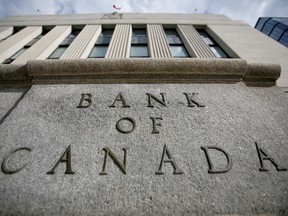So far, memories have been more powerful than anything the central banks have had to do in real life
Article content
The Bank of Canada rarely issues press releases on a Sunday, so the notice that went out on March 19 caused a stir.
Advertisement 2
Article content
Canada’s central bank announced that it was joining with the United States Federal Reserve, the European Central Bank, the Bank of Japan, the Bank of England, and the Swiss National Bank to ensure banks would have unlimited access to U.S. dollars. The objective: to flush fear out of the global financial system.
Article content
The move recalled the financial crisis of 2008, when central banks used the relative quiet of the weekend to devise extraordinary measures to restore calm before markets opened in Australia and Asia. Sunday became the new Monday.
So far, the memories that this new co-ordinated action conjured have been more powerful than anything the central banks have had to do in real life. That suggests the crisis caused by the failure of Silicon Valley Bank and the forced sale of Credit Suisse Group AG hasn’t caused any deep problems, which could be a testament to the measures central banks and regulators created a decade ago to contain financial contagion.
Article content
Advertisement 3
Article content
Here’s what you need to know about what the Bank of Canada did over the weekend.
Backstory
The original mandate of the modern central bank — before they became inflation fighters — was to stand ready to douse financial panics by being a “lender of last resort.” The way they do that is by making cash available to private lenders under conditions that would be unattractive in normal times — but very attractive when there are no other options.
It works well when the troubled lender needs local currency, because central banks can create as much as they need. It works less well when the troubled lender needs U.S. dollars, which is now very often the case because so much of the world’s goods and services are priced in America’s currency. Central banks such as the ECB and the Bank of England have plenty of dollars in reserve, but they don’t have an unlimited supply. When the 2008 crisis was most acute, there weren’t enough dollars to keep Wall Street and the City of London pumping cash through the global financial system. Credit creation froze.
Advertisement 4
Article content

Central banks, led by the Federal Reserve, figured out a fix: they set up “swap arrangements” (also called “swap lines”) that would allow them to draw on each other’s reserves of U.S. dollars (and other currencies) when they started to run low. In effect, the Fed became the lender of last resort for the world.
When the Great Recession passed, the central banks decided to leave some of these programs in place in case they were ever needed again. Fearing how markets might interpret the near failure of a big international financial institution, the Bank of Canada and its counterparts decided over the weekend to hold auctions for dollars daily starting March 20, rather than weekly.
These “daily operations” will “continue at least through the end of April,” the central banks said in a statement.
Advertisement 5
Article content
Historical context
Canada is known for producing quality technocrats whose opinions are valued around the world. And the country is big enough that it’s often invited to the rooms where the biggest decisions are made. But when it comes to the global financial system, it’s only the Federal Reserve, the ECB and the Bank of England that matter.
Paul Volcker, the former Fed chair, recalled in his 2018 memoir how the Group of Seven came to be. Finance ministers and central bankers from the U.S., Japan, the United Kingdom, Germany and France gathered at the Louvre in Paris 1987 to agree on an approach to managing exchange rates.
“As a historical note,” Volcker wrote, “the Italian finance minister learned of the meeting and appeared at the doorstep demanding entry. After long negotiation he rejected the offer to provide him with a post-decision briefing and left. Then the Canadian minister appeared. He accepted the offer of a briefing. That’s how the Group of Five edged momentarily toward a Group of Six. By the next meeting a little later, it became the Group of Seven.”
Advertisement 6
Article content
The dynamics haven’t changed. Canada gets to wave its flag, but it’s rarely involved in the action.
What happened Monday?
The Financial Times reported that the Bank of Japan and the Bank of England received no bids, while the European Central Bank allotted just US$5 million to a single bidder. That’s positive. European and U.S. banks stocks rebounded.
Canadian bank stocks stabilized after a rough week and were little changed at midday on March 20. That had nothing to do with the Bank of Canada.
A spokesperson said that unlike the other central banks in the group, the Bank of Canada wasn’t planning to start daily auctions of dollars because there was no practical reason to do so. That’s because all of Canada’s major financial institutions have U.S. operations that allow them to access dollars directly from the Fed.
-

Bank of Canada joins scramble to calm markets
-

Even if this crisis isn’t a repeat of 2008, it won’t be a picnic
-

3 things to watch as the world teeters on edge of banking crisis
But if Canada’s partners find themselves running short of Canadian dollars, the Bank of Canada stands ready to help.
• Email: kcarmichael@postmedia.com | Twitter: carmichaelkevin
Bank of Canada, peers stir memories of 2008 crisis: What to know
2023-03-20 16:59:35








Comments
Postmedia is committed to maintaining a lively but civil forum for discussion and encourage all readers to share their views on our articles. Comments may take up to an hour for moderation before appearing on the site. We ask you to keep your comments relevant and respectful. We have enabled email notifications—you will now receive an email if you receive a reply to your comment, there is an update to a comment thread you follow or if a user you follow comments. Visit our Community Guidelines for more information and details on how to adjust your email settings.
Join the Conversation